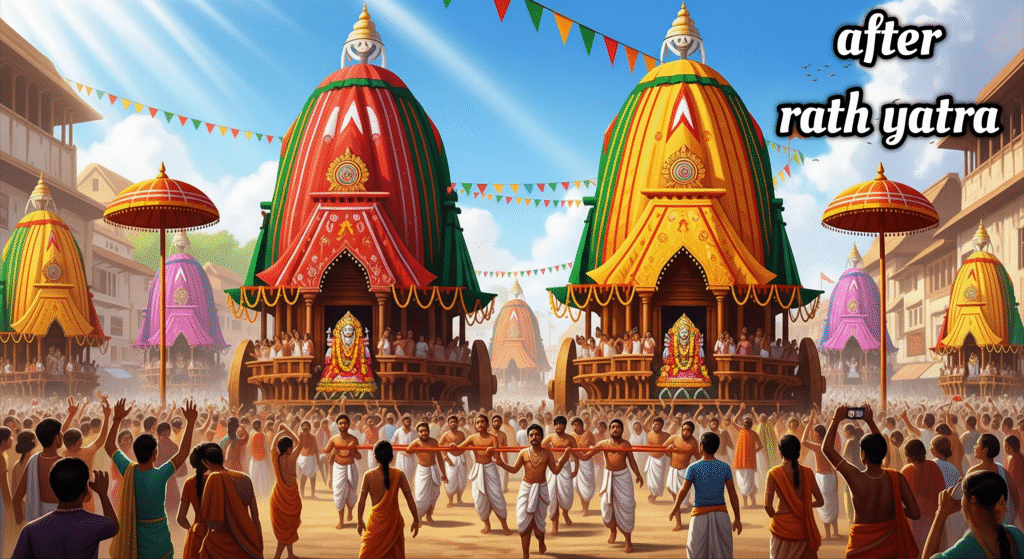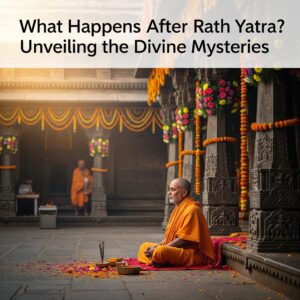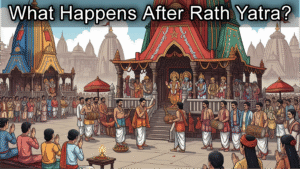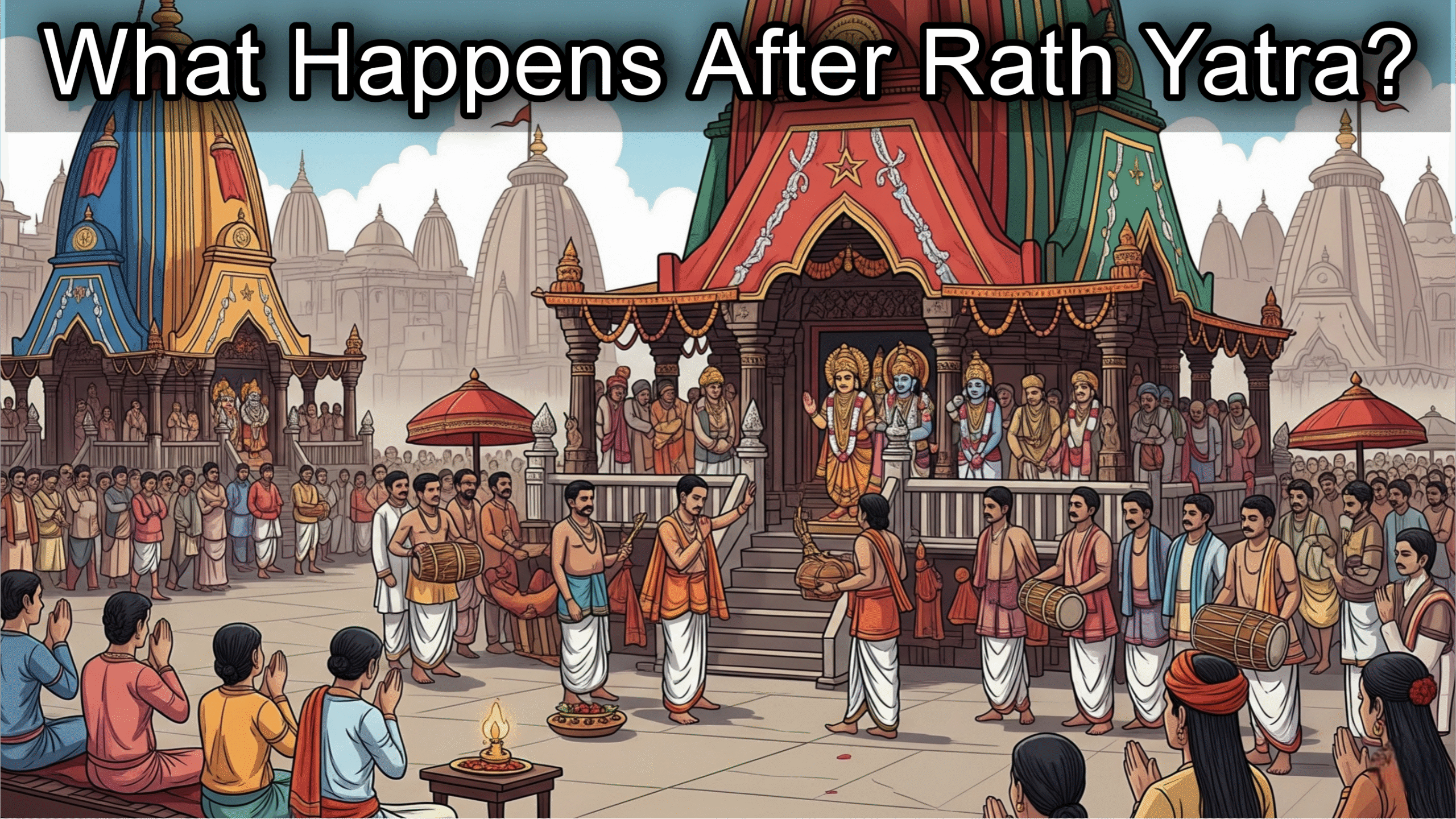
What Happens After Rath Yatra?
The Rath Yatra of Lord Jagannath is not just a grand festival—it is a spiritual journey deeply rooted in Sanatan Dharma. While the Rath Yatra itself draws millions of devotees, one question often arises:
“What happens after the Rath Yatra?”
Let’s explore the divine traditions and mystical events that take place after the chariots come to a halt at the Gundicha Temple.
Nine Days at Gundicha Temple
After the Rath Yatra, Lord Jagannath, along with His siblings Balabhadra and Subhadra, stays at the Gundicha Temple for nine days. This temple is considered the maternal aunt’s home (मौसी का घर).
These nine days are a period of rest and intimate connection with devotees. The temple is beautifully decorated, and special bhogs (offerings) are made every day. It is believed the Lord listens closely to the heartfelt prayers of His devotees during this time.
Table of Contents
Bahuda Yatra – The Return Journey
After nine days, the deities begin their return journey, called Bahuda Yatra, back to the Shri Jagannath Temple. This journey is equally grand and spiritually uplifting.
However, the Lord does not directly enter the temple upon arrival.
Suna Besha – The Golden Adornment
On the evening of Bahuda Yatra, a special ritual called Suna Besha (Golden Attire) is performed. Lord Jagannath, Balabhadra, and Subhadra are adorned with solid gold ornaments and crowns.
This divine spectacle attracts lakhs of devotees and is considered a once-a-year opportunity to witness the Lord’s royal form.

Adhara Pana Ritual
After Suna Besha, a sacred drink called Adhara Pana is offered to the deities. It is made of milk, banana, coconut, tulsi, and sugar.
Interestingly, this drink is placed in huge pots and then intentionally broken, letting it spill near the chariot—symbolizing offering grace to evil spirits and freeing them through divine mercy.
Niladri Bije – The Final Return to the Temple
The last and most emotional part of the Rath Yatra is Niladri Bije, when Lord Jagannath finally returns to His sanctum in the Shri Mandir.
But there’s a twist!
Goddess Lakshmi’s Displeasure
During Rath Yatra, Lord Jagannath leaves without informing His consort, Goddess Lakshmi. When He returns, she is upset and orders the temple gates to be closed.
The Lord tries to appease Her with sweet words and apologies. This playful interaction, full of divine drama and love, is enacted every year.
Eventually, the Goddess forgives Him, and He is allowed to re-enter the temple, marking the end of the Rath Yatra festival.
Conclusion
The Rath Yatra is not just a spiritual procession—it’s a divine love story full of emotion, tradition, and cosmic significance.
The rituals after the Rath Yatra remind us that the Divine too plays roles like us—they rest, they love, they argue, they make up.
Above all, it teaches that in Bhakti (devotion), emotion and surrender matter more than ritual.
🔔 Bonus Tips:
You can watch the live telecast or YouTube streaming of Bahuda Yatra and Niladri Bije every year.
The Rath Yatra usually starts on Ashadha Shukla Dwitiya (June–July) and lasts around 13–15 days.
Jai Jagannath! May His blessings be with you always. 🙏🌼

🕉️ FAQs – What Happens After Rath Yatra?
- How many days do Lord Jagannath and His siblings stay at the Gundicha Temple?
They stay for 9 days at Gundicha Temple after the Rath Yatra, symbolizing rest and reunion with their maternal aunt.
- What is Bahuda Yatra?
Bahuda Yatra is the return journey of Lord Jagannath, Balabhadra, and Subhadra from Gundicha Temple back to the Jagannath Temple in Puri.
- What happens during Suna Besha?
On the day of Bahuda Yatra, the deities are adorned in gold ornaments while seated on their chariots. This divine appearance is called Suna Besha or Golden Attire.
- What is Adhara Pana?
Adhara Pana is a sacred drink offered to the deities and then spilled near the chariots. It is believed to satisfy evil spirits and grant them liberation.
- Why is Goddess Lakshmi angry during Niladri Bije?
Because Lord Jagannath leaves for the Rath Yatra without informing Her. As a result, She blocks the temple gate when He returns, leading to a symbolic reconciliation.
- What is Niladri Bije?
Niladri Bije is the final ritual of Rath Yatra when the deities re-enter the Jagannath Temple after persuasion from Lord Jagannath to Goddess Lakshmi.
- Is Rath Yatra the same as Bahuda Yatra?
No. Rath Yatra is the outward journey to Gundicha Temple, while Bahuda Yatra is the return journey back to the main Jagannath Temple.
- Can devotees enter Gundicha Temple during the 9-day stay?
Yes, during these 9 days, devotees can enter and worship the deities at Gundicha Temple, which remains open to the public.
- Why are the chariots not brought back immediately?
The chariots stay outside the main temple during Bahuda Yatra. The final return to the temple is only after Niladri Bije, signifying divine approval.
- What spiritual message does Rath Yatra convey?
Rath Yatra teaches the values of bhakti (devotion), humility, divine love, and the temporary nature of worldly roles, even for the Divine.
📝 Summary
After the grand Rath Yatra, Lord Jagannath, Balabhadra, and Subhadra stay for nine days at the Gundicha Temple, symbolizing rest and reunion. This is followed by their return journey called Bahuda Yatra.
On their return, the deities are adorned in gold during the Suna Besha ritual, and offered a sacred drink called Adhara Pana, which is spilled as a symbolic offering to spirits seeking liberation.
The final ritual, Niladri Bije, marks the deities’ re-entry into the Jagannath Temple. But before entering, Lord Jagannath has to pacify Goddess Lakshmi, who is upset as He left without informing Her.
These divine events reflect the depth of spiritual love, humility, and human-like emotions even in gods—reminding us that devotion with feeling (bhava bhakti) is supreme in Sanatan Dharma.
Unlock the Ancient Wisdom of Sanatan Dharma – Join Us on YouTube!
👉 Subscribe now to Prachin Sanatan Dharma and embark on a journey of enlightenment.
Explore timeless teachings, spiritual insights, and cultural richness on our YouTube channel, Prachin Sanatan Dharma. Dive deep into the essence of Sanatan Dharma through captivating videos that inspire and educate.
Related Articles
- Restful Nights: Ayurvedic Remedies and Traditional Indian Practices to Overcome Insomnia and Late-Night Habits
- The Tridevi: Lakshmi, Saraswati, and Parvati – Their Roles and Powers
- “Divine Creatures of Ancient Indian Scriptures: Exploring the Role of Animals in the Vedas, Puranas, and Mahabharata”
- Nature and Spirituality: Exploring the Sacred Essence of the Himalayas, Ganga, and Other Natural Wonders”
- “Reviving the Gurukul System: Relevance and Lessons for Modern Education”
- “Exploring Greek and Indian Mythology: Similarities Between Greek and Indian Mythology “
- “Embracing Sattvic Living: Harmonizing Mind, Body, and Soul Through Food and Lifestyle”
- “Charity and Prosperity: Exploring the Concept of Daan and Its Financial Relevance in Modern Life”
- How to Build an Eco-Friendly Home Inspired by Vastu Shastra
- Comparison of Ancient and Modern Sports: How Traditional Sports Have Influenced Contemporary Games
- “Timeless Lessons from Ancient Tales: Linking Samudra Manthan and Ganga’s Descent to Modern Ecological Challenges”
- “Reviving Sanskrit: How AI is Preserving Ancient Languages for the Future”
- “Mathura: The Sacred Land of Lord Krishna’s Divine Leelas”
- Investing for Future Generations: Lessons from Indian Traditions on Legacy Building and Wealth Preservation
- “Ancient Indian Wisdom: Timeless Lessons for Tackling Today’s Climate Crisis”
- “Artificial Intelligence and Spirituality: Transforming Ancient Practices for the Modern World”
- “Gold and Real Estate in India: Timeless Assets Shaping Financial Strategies”
- Tradition Meets Innovation: The Evolution of Technology in Hindu Rituals
- End-of-World Myths: Exploring Kali Yuga in Hinduism and Ragnarök in Norse Mythology
- Garuda, Pegasus, and Dragons: The Universal Ties of Mythical Beasts Across Cultures
- “Ancient Vimanas: Mythical Flying Machines or Evidence of Advanced Technology?”
- Time Travel in Hindu Mythology: The Fascinating Tales of Kakudmi and King Raivata
- “Divine Feminine Power in Hindu Mythology: The Legends of Durga, Saraswati, and Lakshmi”
- “Divine Beings of Sanatan Dharma: The Spiritual Significance of Sacred Animals in Hinduism”
- “Symbolism in Mythological Art: Unlocking Hidden Meanings in Ancient Temple Carvings”
- “Exploring Technological Advancements in Ancient India and Civilizations: Vimana, Metallurgy, & Water Management systems”
- Unveiling the Mysteries: Ancient Temples of Sanatan Dharma , Mysterious Temples of India
- “The Scientific Knowledge of Sanatan Dharma: Ancient Wisdom Meets Modern Science”
- Ancient Indian Sports and Games: Celebrating a Legacy of Skill, Strength & Strategy”
- “Exploring the Cosmic Link: The Connection Between Astronomy and Vedic Astrology”
- The Power of Sanskrit: Unlocking the Divine Language of the Gods
- “The End of Kaliyuga: A Sanatan Insight into the World’s Final Chapter”
- Explore more articles on Prachin Sanatan Yuga.
What Happens After Rath Yatra? Unveiling the Divine Mysteries What Happens After Rath Yatra? Unveiling the Divine Mysteries What Happens After Rath Yatra? Unveiling the Divine Mysteries What Happens After Rath Yatra? Unveiling the Divine Mysteries What Happens After Rath Yatra? Unveiling the Divine Mysteries
What Happens After Rath Yatra? Unveiling the Divine Mysteries What Happens After Rath Yatra? Unveiling the Divine Mysteries What Happens After Rath Yatra? Unveiling the Divine Mysteries What Happens After Rath Yatra? Unveiling the Divine Mysteries What Happens After Rath Yatra? Unveiling the Divine Mysteries
What Happens After Rath Yatra? Unveiling the Divine Mysteries What Happens After Rath Yatra? Unveiling the Divine Mysteries What Happens After Rath Yatra? Unveiling the Divine Mysteries What Happens After Rath Yatra? Unveiling the Divine Mysteries What Happens After Rath Yatra? Unveiling the Divine Mysteries
